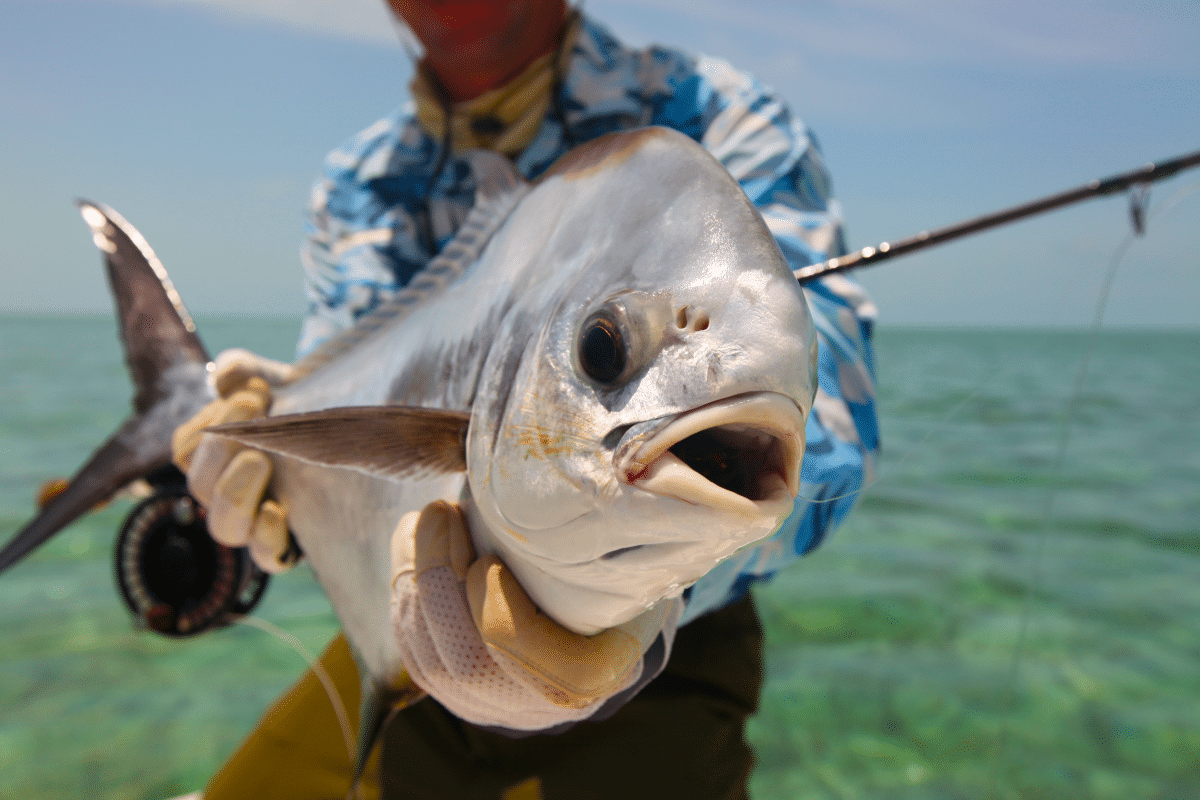
Last Updated on February 18, 2021 by Eric Bonneman
Targeting Permit along the Florida inshore, flats, and nearshore can be both frustrating and rewarding. This is a difficult to catch species that puts on a fight like a wild man after being hooked. They average in size between 20-50lb (20-30lb is most common) with the Florida record Permit coming in at 56 pounds, 2 ounces (world record at 60lb). Whether on light tackle, on the reef/wrecks, or fly fishing – Permit prove a worthy game fish species.
1. Understanding Permit
Knowledge is power, and when it comes to Permit fishing, understanding what makes them so hard to catch is the top tactic you should have in your knowledge base.
These fish are super sensitive to movement and vibration. They have large eyes and more sensitivity in their lateral lines than most inshore species. These particular aspects make them extremely difficult to get to take a hook. They are wary of any unnatural sights or movements. Knowing this, stealth and presentation need to take center stage while Permit fishing.
Another aspect to consider here is species confusion, Permit (especially smaller ones) are frequently confused with Pompano- and vice-versa. While these fish are from the same family, Permit can be identified by their long dorsal fin. Also, Permit get much larger than Pompano. Where Pompano is in the 2-5lb range, Permit can reach 50lbs.
2. Tackle For Permit
Having the right tools for the job is the next best tactic to understand. While these fish can attain pretty heft weights and put up an amazing battle, with their exceptional vision the line and leader needs to leave as little of a visual footprint as possible. In this, these will be fairly light setups.
Spin Tackle
For spin tackle, the general type of setup you’d expect for most flats fishing is all that is needed. Generally, a 7-8 foot, med-light or medium rod is chosen, alongside 12-15lb braid with a 17-20lb fluoro leader.
Fly Tackle
For fly tackle, you will be using a beefier set up than the usual for the flats. While an 8wt setup is ideal for most species, most trophy Permit will be best handled on a 10wt. In a multi-species fishery, a 9wt can be a great go-to in these circumstances. You’ll want to be set up with a floating fly line and a 10-foot tapered leader between 17-20lbs.
3. Baits and Lures
Permit pretty much only eat crustaceans; namely, blue crabs, pass crabs, and shrimp. In this, your bait and lure selection must match. Most anglers on spin tackle will be using live baits for Permit. In this, silver dollar-sized crabs are ideal, alongside jumbo-sized shrimp (hooked through the tail). Chunks of crab, and even lobster, can be worked on naturally colored jig heads as well.
Fly fisherman will have the hardest time with Permit, but the most effective flies will be those same crab and shrimp patterns, with weighted/sinking heads.
4. Finding Permit
With your now established knowledgebase on Permit characteristics, gear, and baits/lures- the next tactic is the most important, where to find them. Permit, in general, are found in Florida, the Bahamas, and the Caribbean. In Florida, they can be found on both coasts, but more significantly in the southern half of the state. They like warm water and will migrate to those areas when the temps dip in the north.
They can be found in deeper water on reefs and wrecks, sight fished in the southern areas (Dade County and the Keys), and in all other inshore fisheries – the surf, inlets, and passes will work best, especially during moving tides.
In shallower waters, when their fin is out of the water, they can be recognized by the wild pattern they leave in their surface wake. In these cases, Permit are usually solitary – whereas in deeper water they can be schooled up. They can also be spotted tailing when busy feeding off the bottom.
5. Fighting the Permit
While your heart might jump and most likely a scream is let out on hook-up, with this hard-to-target species, fighting and landing this fish is the final step towards complete success.
This fish will put a ton of pressure on your setup. Making strong, wild runs and gunning for structure if available. Open water is going to be best your bet for a successful landing. Taking your time to wear the fish out a bit will be necessary. Breaking off Permit is fairly common in many cases, finesse is key – alongside steady pressure. When the drag starts slowing and you can begin to make ground with your line, do so – but if it starts peeling again, let it run. These fights can last 20-30 minutes – some say, “1 minute per pound”.
